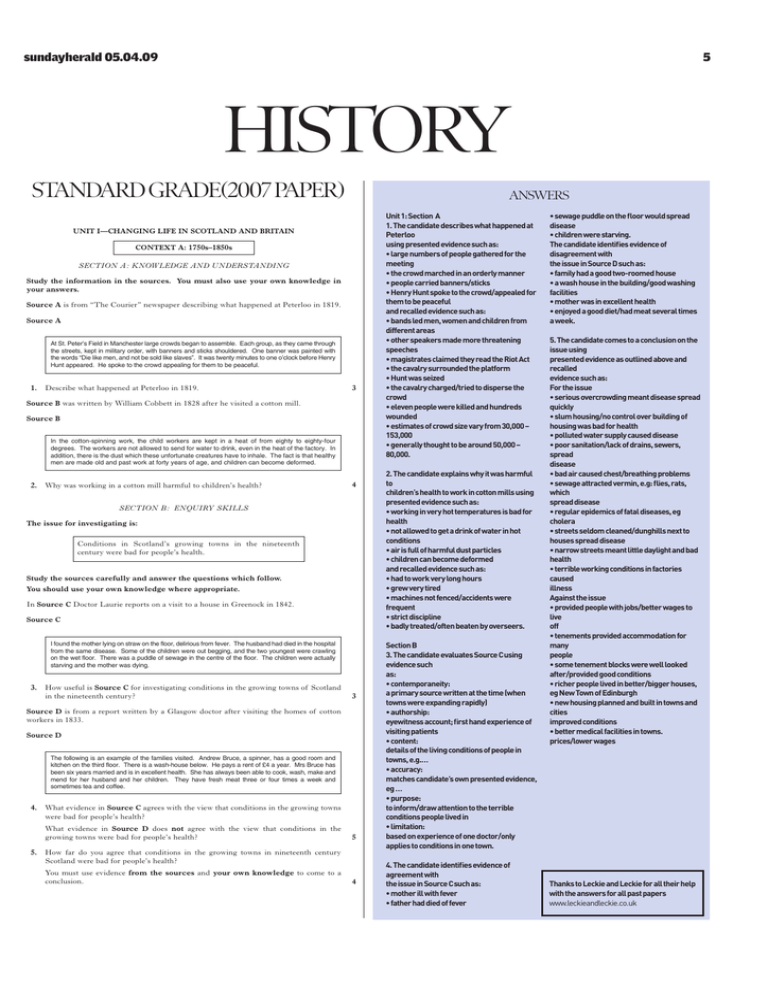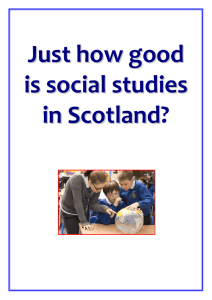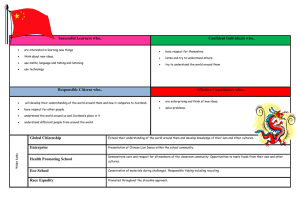HISTORY STANDARDGRADE(2007PAPER) ANSWERS
advertisement

sundayherald 05.04.09 5 HISTORY STANDARDGRADE(2007 PAPER) ANSWERS UNIT I—CHANGING LIFE IN SCOTLAND AND BRITAIN CONTEXT A: 1750s–1850s SECTION A: KNOWLEDGE AND UNDERSTANDING Study the information in the sources. You must also use your own knowledge in your answers. Source A is from “The Courier” newspaper describing what happened at Peterloo in 1819. Source A At St. Peter’s Field in Manchester large crowds began to assemble. Each group, as they came through the streets, kept in military order, with banners and sticks shouldered. One banner was painted with the words “Die like men, and not be sold like slaves”. It was twenty minutes to one o’clock before Henry Hunt appeared. He spoke to the crowd appealing for them to be peaceful. 1. Describe what happened at Peterloo in 1819. 3 Source B was written by William Cobbett in 1828 after he visited a cotton mill. Source B In the cotton-spinning work, the child workers are kept in a heat of from eighty to eighty-four degrees. The workers are not allowed to send for water to drink, even in the heat of the factory. In addition, there is the dust which these unfortunate creatures have to inhale. The fact is that healthy men are made old and past work at forty years of age, and children can become deformed. 2. Why was working in a cotton mill harmful to children’s health? 4 SECTION B: ENQUIRY SKILLS The issue for investigating is: Conditions in Scotland’s growing towns in the nineteenth century were bad for people’s health. Study the sources carefully and answer the questions which follow. You should use your own knowledge where appropriate. In Source C Doctor Laurie reports on a visit to a house in Greenock in 1842. Source C I found the mother lying on straw on the floor, delirious from fever. The husband had died in the hospital from the same disease. Some of the children were out begging, and the two youngest were crawling on the wet floor. There was a puddle of sewage in the centre of the floor. The children were actually starving and the mother was dying. 3. How useful is Source C for investigating conditions in the growing towns of Scotland in the nineteenth century? 3 Source D is from a report written by a Glasgow doctor after visiting the homes of cotton workers in 1833. Source D The following is an example of the families visited. Andrew Bruce, a spinner, has a good room and kitchen on the third floor. There is a wash-house below. He pays a rent of £4 a year. Mrs Bruce has been six years married and is in excellent health. She has always been able to cook, wash, make and mend for her husband and her children. They have fresh meat three or four times a week and sometimes tea and coffee. 4. What evidence in Source C agrees with the view that conditions in the growing towns were bad for people’s health? What evidence in Source D does not agree with the view that conditions in the growing towns were bad for people’s health? 5. 5 How far do you agree that conditions in the growing towns in nineteenth century Scotland were bad for people’s health? You must use evidence from the sources and your own knowledge to come to a conclusion. 4 Unit1:Section A 1.Thecandidatedescribeswhathappenedat Peterloo usingpresentedevidencesuchas: •largenumbersofpeoplegatheredforthe meeting •thecrowdmarchedinanorderlymanner •peoplecarriedbanners/sticks •HenryHuntspoketothecrowd/appealedfor themtobepeaceful andrecalledevidencesuchas: •bandsledmen,womenandchildrenfrom differentareas •otherspeakersmademorethreatening speeches •magistratesclaimedtheyreadtheRiotAct •thecavalrysurroundedtheplatform •Huntwasseized •thecavalrycharged/triedtodispersethe crowd •elevenpeoplewerekilledandhundreds wounded •estimatesofcrowdsizevaryfrom30,000– 153,000 •generallythoughttobearound50,000– 80,000. 2.Thecandidateexplainswhyitwasharmful to children’shealthtoworkincottonmillsusing presentedevidencesuchas: •workinginveryhottemperaturesisbadfor health •notallowedtogetadrinkofwaterinhot conditions •airisfullofharmfuldustparticles •childrencanbecomedeformed andrecalledevidencesuchas: •hadtoworkverylonghours •grewverytired •machinesnotfenced/accidentswere frequent •strictdiscipline •badlytreated/oftenbeatenbyoverseers. SectionB 3.ThecandidateevaluatesSourceCusing evidencesuch as: •contemporaneity: aprimarysourcewrittenatthetime(when townswereexpandingrapidly) •authorship: eyewitnessaccount;firsthandexperienceof visitingpatients •content: detailsofthelivingconditionsofpeoplein towns,e.g.… •accuracy: matchescandidate’sownpresentedevidence, eg… •purpose: toinform/drawattentiontotheterrible conditionspeoplelivedin •limitation: basedonexperienceofonedoctor/only appliestoconditionsinonetown. 4.Thecandidateidentifiesevidenceof agreementwith theissueinSourceCsuchas: •motherillwithfever •fatherhaddiedoffever •sewagepuddleonthefloorwouldspread disease •childrenwerestarving. Thecandidateidentifiesevidenceof disagreementwith theissueinSourceDsuchas: •familyhadagoodtwo-roomedhouse •awashhouseinthebuilding/goodwashing facilities •motherwasinexcellenthealth •enjoyedagooddiet/hadmeatseveraltimes aweek. 5.Thecandidatecomestoaconclusiononthe issueusing presentedevidenceasoutlinedaboveand recalled evidencesuchas: Fortheissue •seriousovercrowdingmeantdiseasespread quickly •slumhousing/nocontroloverbuildingof housingwasbadforhealth •pollutedwatersupplycauseddisease •poorsanitation/lackofdrains,sewers, spread disease •badaircausedchest/breathingproblems •sewageattractedvermin,e.g:flies,rats, which spreaddisease •regularepidemicsoffataldiseases,eg cholera •streetsseldomcleaned/dunghillsnextto housesspreaddisease •narrowstreetsmeantlittledaylightandbad health •terribleworkingconditionsinfactories caused illness Againsttheissue •providedpeoplewithjobs/betterwagesto live off •tenementsprovidedaccommodationfor many people •sometenementblockswerewelllooked after/providedgoodconditions •richerpeoplelivedinbetter/biggerhouses, egNewTownofEdinburgh •newhousingplannedandbuiltintownsand cities improvedconditions •bettermedicalfacilitiesintowns. prices/lowerwages ThankstoLeckieandLeckieforalltheirhelp withtheanswersforallpastpapers www.leckieandleckie.co.uk 6 05.04.09 sundayherald HIGHER (2008 PAPER,SELECTED QUESTIONS) OPTION B: EARLY MODERN HISTORY Historical Study: Scottish and British EITHER Scotland in the Age of the Reformation 1542–1603 1. How successful was the Roman Catholic Church in its attempts to reform itself before 1560? 2. How far was the death of Mary of Guise the main reason for the success of the Protestant Reformation in Scotland? 3. To what extent was Mary Queen of Scots herself to blame for the loss of her throne in 1567? 4. “Mary’s forced abdication was the main reason for political instability in Scotland in the period 1567–1585.” How valid is this view? 5. How significant were James VI’s relations with the Church in his attempts to strengthen royal authority up to 1603? OR Scotland and England in the Century of Revolutions 1603–1702 6. How far were religious issues the main threat to royal authority under James VI and I? 7. How important were Charles I’s financial policies in weakening his authority in the years before the Civil War? 8. “Purely a response to the attempts of Charles I to impose his religious views on Scotland.” How valid is this view of the growth of the Covenanting movement? 9. To what extent was the Republic successful in overcoming its problems between 1649 and 1660? 10. How successful was the Glorious Revolution in limiting the powers of the Crown? ANSWERS 1.Thecandidatemakesajudgementasto theextenttowhichtheRomanCatholic Churchtriedtodealwithitsinternal problemsbefore1560usingevidenceand argumentssuchas: InternalReforms •CardinalBeatonshowedlittledesireto introducereforms.Lawsintroducedagainst heresyandthecastingdownofimages–Act toallowthenobilityaccesstothescriptures inthevernacularwasshortlived. Assassinated1554. •ArchbishopHamiltonheldanumberof ProvincialCouncils.Strengthenedthe authorityofthebishop,encouragedmore preaching,improvedtheteachingofthefaith –newcatechism.StMary’sCollegesetupto trainpriests.Somehistorianswouldargue reformswere“toolittletoolate”. OtherIssues •DeclineofMonasticism Fewwereenteringthemonasticlife,andthe nunneriesweresufferingfromcorruption. TheFriarieswerehowevermoreactiveas wastheAugustinianorder–someofthem triedtoreformthechurchfromwithin, othersbecameProtestants. •CrownbenefitedfromtheChurch ThismeantthattheCrownhadnoincentive toreformtheChurch.JamesIVandVplaced familymembersinlucrativepostsinthe Church.JamesIV’ssonbecameArchbishop ofStAndrews,aged14. •UnabletostopthegrowthofProtestant ideas ArrivedinScotlandintheeastcoastburghs. PatrickHamiltonfirstProtestantmartyr– ProtestantsbesiegedinStAndrewsCastle. In1550sinterestincreasedwithWishart’s preachingtours.Wishartburntatthestake. After1558,Protestantsencouragedbya friendlyregimeinEngland.ReturnofJohn Knox.Catholicsunsuccessfulinstoppingthis development. •Pluralism MajorproblemintheCatholicChurchbefore 1560,whichwasneveraddressed–where onemanreceivedtheincomeofseveral parishes.Moneywasoftendivertedfromthe parishleveltothehigherclergyand monasteries,thustherewasinadequate provisionintheparishestothedetrimentof churchbuildings,educationandpoorrelief. Anyotherrelevantfactors. 2.MaryofGuise •ShewasregentofScotlandfrom1554, duringwhichtimeshepromotedaproFrenchandpro-catholicpolicy. •Shewasanextremelyablerulerwho governedandlookedafterScotlandforher absentdaughter. •ShehadmanagedtowinmanyScotsover, partlythroughlavishgifts. •HerunexpecteddeathinJune1560, createda‘politicalvacuum’andthusan opportunityfortheProtestantstotake control. •MaryofGuisehadmaintainedFrench troopsinScotland. •DespiteaProtestantrebellionshewas regainingcontrolpriortoherdeath. •TheReformationwasbynomeansa certainty. OtherFactors •TheCatholicChurch’sfailuretoreform itself–Itfailedtodealsufficientlywiththe challengefromProtestantideas.Itfailedto dealwithPluralismandothercorruptionsin thesystem. •IncreasedconfidenceamongstProtestant Scotsafter1558–Reason–aProtestant QueeninEngland.‘BeggarsSummons’, Knoxreturned,preachinginPerth.Both PerthandDundeedeclaredasProtestant towns.Increasingnumbersofnobilitynow preparedtoshowtheirtrueallegiances. LordsoftheCongregationtookuparms. •Englishintervention–Englishsentafleet totheForth–aimtocutFrenchsupplylines. •ArmysentintoSEScotland.Spring1560. •TheProtestantswereactiveandorganised totakeadvantageofthesituation.Therewas incontrastnoleadershipfromtheCatholic Church–theArchbishopofGlasgowfledto France. 3BishopsjoinedtheProtestants. •TheTreatyofEdinburghremovedFrench and EnglishtroopsfromScotlandandthe ReformationParliamentdeclaredScotland tohaveacceptedtheReformedfaith. Anyotherrelevantfactors Thecandidatemakesajudgementabout Mary’sroleinbringingaboutthelossofher throne,usingevidenceandargumentssuch as: •Mary’spoorchoiceofhusbands.Herpoor choiceofhusbandshadalienatedmanyof hernobles. •MarriagetoDarnleyresultedintheChaseAboutRaidwhich,althoughanunsuccessful rebellion,lostherthesupportofherhalf brother,theEarlofMoray. •Somehistoriansarguethathewasthe powerbehindthethroneafterherreturn fromFrance.Darnleyprovedtobean unsuitablecharacter,bothmorallyandinhis demandforthecrownmatrimonial. •TheRicciomurderstemmedfromhis jealousy.Birthofasonprovidesanheirbut alsopotentialalternativemonarch. •Mary’sseparationfromDarnleyand increasedfriendshipwithBothwell–he stage-managesthebaptismofherson. Darnleydoesnotevenattend. •ImplicatedinDarnley’smurder.Shefailsto mournhimandverysoonaftermarries Bothwell. •BothwellisthechiefsuspectinDarnley’s murder.Notapopularchoiceforahusband. Protestantweddingalienatessome CatholicsandtheCatholicpowersofEurope arenotimpressed.Thismarriagecreates enoughillfeelingtoforcesomeofthenobles totakeuparmsastheConfederateLords. •Roleofherhalf-brotherLordJames Stewart(Moray)forcedabdicationonMary. HasherimprisonedinLochLevenCastle. TheinfantJamesisdeclaredKingwith Morayasregent. OtherFactors •Maryhadaverypoorrecordatattending herCouncilmeetings.Noblesfeltneglected. Sheisolatedherselfandsurroundedherself withFrenchservants.Shealsosuffered fromdepressiononanumberofoccasions. •DifficultyofaCatholicQueenina Protestantland.Auniquesituationinthis periodforthemonarchtobeadifferent religionfromthatoftheirrealm.Marydoes verylittlefortheCatholicfaithandthereis virtuallynoattempttoreversethe reformationof1560. 4.Thecandidatemakesajudgementasto thevalidityofthisview,usingevidenceand argumentssuchas: •Abdication1567ConfederateLords rebelledagainstMaryandhernewhusband Bothwell.Maryisforcedtoabdicateinfavour ofherson,withMorayasregent.The followingyearsheescapesfromprison. BattleofLangside–herforcesledby HamiltonaredefeatedbyMoray.Thiswas thebeginningofacivilwar,whichwastolast until1573.MariansvKing’sParty.Mary escapestoexileandimprisonmentin England. •MorayasRegenthastodealwiththiscivil unrestfightingissporadicbuthasanegative impactontheeconomy.Moraymurdered 1570. •EnglishinterventionTheEnglisharekeen toinfluenceaffairs–supporttheKing’s Partyastheywouldpreferafriendlyregime inScotland.Thenewregent,Lennox,is Elizabeth’ssuggestion.Englishtroopsassist inthesiegeofDumbartonCastle,Hamilton stronghold(Marians)–Lennoxalsomeetsa violentdeath. •RegencyofMorton Duringthisperiodthecivilwarendsanda periodofrelativestabilitybegins.Edinburgh Castle,lastoutpostforMary,iscapturedwith Englishassistance.Otherfactorswhich causedunrestafter1574 •ConflictwiththeChurch Morton’schurchsettlementbroughthim intoconflictwiththePresbyterians(anew movementinthechurchledbyAndrew Melville). •FinancialProblems Largelyasaresultofcivilwarfinancial problemswerecreated. •Mortonexecuted1581. •ProblemscreatedbyEsmeStuart InfluenceoveryoungJames–Elizabeth,the KirkandtheProtestantnobilitysawhimas anagentofthePope. •TheRuthvenRaidresultedinthecapture andimprisonmentofJamesfor10months. •Clearlyafter1574,theunrestcausedby Mary’sforcedabdicationhadlargelydiedout butsomeinstabilityremainedthroughout thisperiod. 5.Thecandidatemakesajudgementasto theimportanceofJames’relationswiththe churchinestablishinghisauthorityusing evidenceandargumentssuchas: ConflictwithPresbyterians •Newmovementinthechurchledby AndrewMelville–conflicthadalready developedduringMorton’sregency.King wantedachurchwithbishops. •1570sshortageofclergy–fearofCounter Reformation. •1581–13Presbyterssetup–seenasa challengetoroyalauthority. •1584–‘BlackActs’subjectedtheKirkto authorityofthecrown.Ministersareasked tosubscribe–anumbergointoexile. •1592–‘GoldenActs’reaffirmedthe privilegesoftheKirk,GeneralAssemblyand Presbyteries.HowevertheGeneral Assemblycouldonlymeetwiththeconsent oftheKing. •IncreasinglyJameswouldhavethe General AssembliesmeetingintheNorthEastwhere hecouldrelyonmoresupportforthecrown. •In1600JamesappointedBishopsto Parliament.Hehadclearlygonefarinhis attemptstocontroltheKirkandthushelpto controlthestate. OtherFactors •Jamesworkedtobringlawandordertohis kingdom–jointpolicingtookplaceinthe Borders.Attemptsweremadetobring controltothehighlands.Attemptswere madetosettle‘civilised’ScotsfromFifeon Lewis. •Successfullycrushedtherebellionof HuntlyandBothwell. •Creationofanimageofkingship–Poets– BasilikonDoran–TractsonKingship. ScotlandandEnglandintheCenturyof Revolutions1603–1702 6.Thecandidatemakesajudgementasto theextenttowhichreligiousissues threatenedroyalauthority,usingevidence sundayherald 05.04.09 andargumentssuchas: Religiousissues–England •James’willingnesstogivesometolerationto Catholicsnotalwayswelcomed. •1606harshpenallawsintroducedbutnot rigorouslyenforced. •AminorityofCatholicsorganisedagainstthe crown–egGunpowderplot. •MoreconcernwiththePuritans–atstartof thereignhadhopedforfurtherchangesinthe church–MillenaryPetition.Jamestriedto meetthemhalfwayattheHamptonCourt Conference.Agreedtosomeoftheirdemands butinsistedonBishopsinthechurch. AuthorisedVersionoftheBibleproduced. Despitetheseproblemsreligionwasnevera majordivisiveissueinhisreign. Religiousissues–Scotland •JameswassuccessfulinintroducingBishops intotheKirk.The5ArticlesofPerth–kneeling atCommunioncreatedopposition.James wantedtointroduceanewliturgybuthadthe senseandknowledgeofScotlandtoholdback. •Jamesboastedthathecouldnowrule Scotlandbythepenwhereothershadfailedby thesword. Otherissues •AimofJameswastocreateoneunifiedGreat Britain.JameswantedtoseeaUnionofequals; hisEnglishParliamentdidnotwelcomethis. EnglishalsoresentedhisScottishfavourites aroundthecourt. •ProblemswithParliament Jamesimposedcustomsdutieswithoutthe consentofParliament.Jamesalsoopenlysold honourstoraisecash.Fearexistedofroyal interferencewithParliament–thiswasnot helpedbyhisviewsonthe‘DivineRightof Kings’.DisputedBuckinghamshireelection– assertedprerogativeonreligiousmatters. •JamesruledwithoutParliamentfor7years (1614-21).In1621Parliamentchallengedthe sellingofmonopolies. •ThroughoutJames’reignamajorproblem wastheinabilitytosecuresufficientfinancefor theCrown. •ForeignPolicy Jamespursuedoneofpeaceformostofhis reign.HoweverpeacewithSpainnotalwaysa popularpolicyinEngland. Anyotherrelevantfactors 7.Thecandidatemakesajudgementastothe importanceoffinancialpoliciesinweakening Charles’authorityintheyearsbeforethecivil warusingevidenceandarguments suchas: FinancialPolicies •SomehistorianshavearguedthatCharles inheritedproblemsfromhisfather’sreign. However,Charleswaslessabletodealwith themsuccessfully.Atthestartofhisreignhe wasrefusedTonnageandPoundage.In1627he wastointroduceforcedloans–refusalcould resultinforcedconscriptionorimprisonment. Healsohadsoldiersbilletedonprivate individualswithoutpayment. •Duringtheperiodofhisrulewithout Parliamentheexploitedandrevivedancient feudalrightstoincreaserevenue.Examples– CommissionforKnighthoods,Infringementof RoyalForests,ShipMoney(atfirstcoastal townsthenthewholecountry). •HealsoillegallygatheredTonnageand Poundage. Charles’personality •Stubborn–likedtobeobeyed–believedinthe ‘DivineRightofKings’. •Catholicmarriageunpopular. •ResentmentatBuckingham’sinfluence duringthefirstpartofhisreign.Failuretowork withParliament •HisconflictwithParliamentresultedinno Parliamentbeingcalledfrom1629-40. •Parliamenthadcriticisedhisfinancialand 7 religiouspolicy.Parliamentonlymetin1640 whenhewasforcedtoaskformoremoneyto dealwiththeScotsrebellion. •Parliamentbelievedthatwhereministers actedinwaysdangeroustothestateorreligion, thatitwasitsdutytocallthemtoaccount. Religion •Charleswascommittedtoonegroupwithin thechurchknownasArminians.Thiswasa majorbreakwiththeCalvinismofthe Reformation. •HepromotedWilliamLaudinthechurch– ArchbishopofCanterbury1633. •Somefearedincreasedritualinthechurchas Catholicism. •Heenhancedthepositionofbishopsinthe Church–whichgavedivineauthoritytothe monarch. ForeignPolicy •AtfirsthiswarwithSpainwaspopularbutit provedtobeafiascowithFrancealsodeclaring warin1627. •Peacewasachievedin1629. Anyotherrelevantfactors 8.Thecandidatemakesajudgementastothe importanceofCharles’religiousviewsin bringingaboutthegrowthoftheCovenanting movement,usingevidenceandarguments suchas: Religiousissues •JamesVIhadreintroducedBishopsintothe Kirk.ThefiveArticlesofPerthwerepassedbya GeneralAssemblyandreluctantlywent throughParliament.Theiraimwastobring conformitywiththeChurchofEngland.James hadthesensetotakethingsnofurther– Charleslackedhisfather’sunderstandingof Scotland. •Charleswasinsistentinachievinguniformity intheChurchofbothKingdoms.Archbishop LaudhadalreadymadechangesinEngland. Bishopsweregivenofficeingovernment. •1633–CharleswascrownedinScotland.The 8-yeardelaycausedresentment.Coronation tookplacewithfullAnglicanrites–choir, music,candles,clergyinvestments–wasthisa signofthingstocome? •1635–BookofCanons–gavemorepowersto thebishops. •1637–introductionofnewprayerbook– resultedinriots–plannedwellinadvance. •MorezealousPresbyteriansstartedtomeet inprivateforworship. •ResultwastheNationalCovenant–this receivedwidespreadsupport. OtherFactors •TheRevocationActwasamajorlong-term factorincausingdiscontent.Itannulledallgifts oflandsince1540!(BeforetheReformation). Theaimwastoreducethepowerofthenobility andprovidestipendsfortheclergy.Ithowever createduncertaintyamongstthenobilityand alienatedtheverypeoplewhomighthave supportedthekingandresultedinmanyofthe nobilityjoiningtheCovenantingMovement. •Highlevelsoftaxation–thiswasneededfor thenewParliamentHouseandforthe renovationofStGiles. •Parliamenthadbeencontrolledbythe CommitteeoftheArticles–thebishopswere importantastheymadenominationstothe committee. •Charles’characterinsistenceonDivineRight –naïve–expectedtobeobeyed. Anyotherrelevantfactors 9.Thecandidatemakesajudgementastothe successoftheRepublicinovercomingits problems,usingevidenceandargumentssuch as: TheRumpParliament1649-53 •ProblemofsecurityforthenewRepublic. Irelandinrevolt–ScotlanddeclaredforCharles II.CromwellsuccessfullyrepressedIrelandbut atacost.ScotsdefeatedatDunbarand Worcester.LaterUnionwouldbeforcedon Scotland.Highcostsofgarrisonsinbothplaces. •CharlesIexecutionhadironicallyincreased hispopularity–Rumpintroducedcensorship anddependedonthearmytomaintaincontrol– thiswasaproblemneversolved. •WarwithHolland ThisresultedinmoreexpensebutNavigation ActsprotectedEnglishtradeandtheRoyal Navywasbuiltup.Englandbegantobe respectedasaNavalpower. •ProblemofconflictbetweenParliamentand theArmy Radicalelementinarmyatoddswith Parliament–JohnLilburne(Levellerleader) imprisonedforcriticisinggovernment.In1653 CromwellbringstroopsintoParliamentand expelstheRumpthuscreatingmoreproblems andreducesthechanceofaconstitutional settlement. •BriefrulebytheBarebonesParliament1653 thenpowerhandedtoCromwell. •HeadofStateandtheArmy SharedpowerwithaCouncilofState.He passedanumberoflawsbeforeParliament met–lawsagainstblasphemyand drunkenness.ConflictwithParliamentledtoit beingdissolved.Cromwellfailedtoimprovehis relationswithParliamentduringhistimeas LordProtector.Yethedidkeeplawandorder andwasacceptedathome–respectedabroad. •DislikeoftheMajorGeneralSystem Thiselementofmilitaryrulewasintroducedby Cromwellandwasveryunpopularasitledto interferenceinindividual’slives.Backedupby troopsitcouldmakeonthespotfines.Enforced lawsagainstswearing,drinking,Sabbath observance.1656theyattemptedtoinfluence theelection. •1657HumblePetitionandAdvice Cromwellofferedthecrown–refusedbut acceptedthepowersofthecrown.Further argumenttosupporttheviewthatitfailedto produceaconstitutionalsettlement.Radical elementintheArmyalienated. •Religion TolerationforallChristiansexceptCatholics andAnglicans. •MajorfailurewastheinabilityoftheRepublic toproduceaconstitutionalsettlement,which wouldlast.OnthedeathofCromwelltheonly solutionappearedtobetherestorationofthe monarchy. Anyotherrelevantfactors 10.Thecandidatemakesajudgementabout thesuccessoftheGloriousRevolutionin limitingthepowerofthecrown,usingevidence andargumentssuchas: ConventionParliament •WilliamandMarytoruleasjointsovereigns– acceptedaccordingtolawandguidedby Parliament. DeclarationofRights •ThispreservedmuchofRoyalpowers– Monarchchoseministers–maketheirown policy-influenceParliament–ownpatronage. •Yetmanyofthepowers,whichJameshad claimed,weredeclaredunconstitutionaleg powerstomakestatutesillegal,packingjuries, taxeswithoutconsentofParliament,nochurch courtsorstandingarmyinpeacetimewithout theconsentofParliament. •Itreinstatedancientrightsratherthangiving newrightstoParliament. RestrictiveSuccession •Thiswasamajorinnovation.Catholicsbarred fromthethrone. Vaguestatementsofintent •Subjectscouldpetitiontheking– parliamentaryelections,debatesand proceedingstobefree–Parliamentsheld ‘frequently’. •No‘cruelorunusualpunishments’. CriticismsoftheGloriousRevolution •NorepealoftheMilitiaAct–Nothingto preventoverlongParliaments.Kingcouldstill alterboroughcharters.Officescouldstillbe boughtandsold.Noindependentjudiciary. •Ithasbeencriticisedasveryconservativeyet theConventionhadlackedtimetolegislateon morethanafewmatters. •Nearestapproachyettoawrittenconstitution. Itimpliedacontractualmonarchy–it entrenchedtheProtestantsettlementand guaranteedtheplaceofParliament. Parliamentgainsmorepowerbecauseofwars •Newparliamentof1690grantedcustomsfor only4years.Thefinancialneedsofwarended thechanceofthemonarchbeingfinancially independent. While the title of the essay would suggest primarily reference to England, some credit should be given if reference is made to Claim of Right and Articles of Grievance in Scotland. The abolition of the Committee of the Articles – making the Scottish Parliament a stronger institution. Anyotherrelevantfactors




